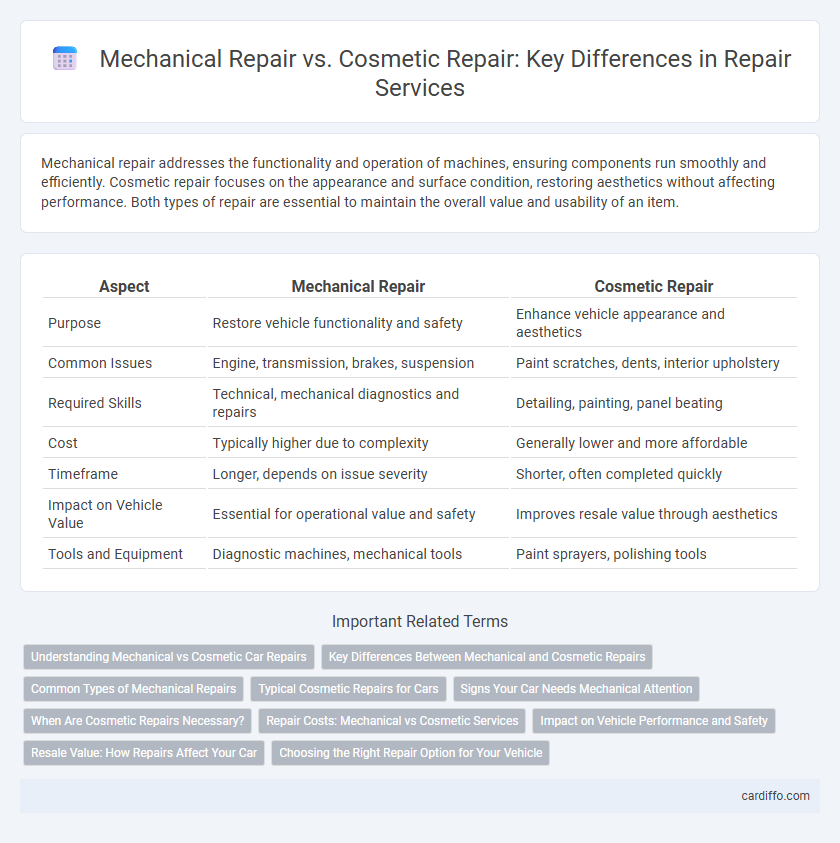Mechanical repair addresses the functionality and operation of machines, ensuring components run smoothly and efficiently. Cosmetic repair focuses on the appearance and surface condition, restoring aesthetics without affecting performance. Both types of repair are essential to maintain the overall value and usability of an item.
Table of Comparison
| Aspect | Mechanical Repair | Cosmetic Repair |
|---|---|---|
| Purpose | Restore vehicle functionality and safety | Enhance vehicle appearance and aesthetics |
| Common Issues | Engine, transmission, brakes, suspension | Paint scratches, dents, interior upholstery |
| Required Skills | Technical, mechanical diagnostics and repairs | Detailing, painting, panel beating |
| Cost | Typically higher due to complexity | Generally lower and more affordable |
| Timeframe | Longer, depends on issue severity | Shorter, often completed quickly |
| Impact on Vehicle Value | Essential for operational value and safety | Improves resale value through aesthetics |
| Tools and Equipment | Diagnostic machines, mechanical tools | Paint sprayers, polishing tools |
Understanding Mechanical vs Cosmetic Car Repairs
Mechanical car repairs focus on restoring the functionality of essential vehicle systems such as the engine, transmission, brakes, and suspension, which directly impact safety and performance. Cosmetic repairs address surface-level issues including paint scratches, dents, and interior upholstery, enhancing the vehicle's appearance without affecting its operational capabilities. Understanding the distinction between these repairs helps prioritize maintenance based on safety needs versus aesthetic preferences, optimizing repair budgets and vehicle lifespan.
Key Differences Between Mechanical and Cosmetic Repairs
Mechanical repair involves fixing or replacing essential functional components such as engines, brakes, and transmissions to restore a vehicle's operational performance. Cosmetic repair focuses on surface-level improvements like paint touch-ups, dent removal, and interior upholstery restoration to enhance the vehicle's aesthetic appeal. Understanding the distinction helps prioritize repairs based on safety, functionality, and appearance requirements.
Common Types of Mechanical Repairs
Common types of mechanical repairs include engine overhauls, transmission repairs, brake system maintenance, and suspension fixes. These repairs address critical vehicle functions ensuring safety and operational efficiency. Unlike cosmetic repair, which focuses on the vehicle's appearance, mechanical repair targets performance and reliability issues.
Typical Cosmetic Repairs for Cars
Typical cosmetic repairs for cars include paint touch-ups, dent removal, scratch repairs, headlight restoration, and bumper refinishing. These repairs enhance a vehicle's appearance without affecting its mechanical function or safety. Cosmetic repairs often involve less time and cost compared to mechanical repairs, making them popular for maintaining resale value and aesthetic appeal.
Signs Your Car Needs Mechanical Attention
Unusual engine noises, such as knocking or grinding, indicate urgent mechanical repair needs to prevent further damage. Persistent warning lights on the dashboard, including the check engine or oil pressure light, signify critical mechanical issues requiring immediate attention. Difficulty starting the car, reduced fuel efficiency, or irregular idling are additional signs that mechanical repair is necessary to maintain vehicle performance.
When Are Cosmetic Repairs Necessary?
Cosmetic repairs become necessary when surface damage, such as scratches, dents, or paint chips, affects the vehicle's aesthetic appeal or resale value. Unlike mechanical repairs that address functional and safety issues, cosmetic repairs restore the exterior to its original appearance, preventing rust or further deterioration. Ensuring timely cosmetic repairs helps maintain a vehicle's market value and overall visual condition.
Repair Costs: Mechanical vs Cosmetic Services
Mechanical repair costs typically exceed cosmetic repair expenses due to the complexity of fixing engine components, transmission systems, and electrical issues. Cosmetic repair services, such as paint touch-ups, dent removal, and interior refurbishment, generally involve less labor and materials, resulting in lower overall charges. Understanding the distinction in repair costs helps vehicle owners budget effectively for maintenance and restoration needs.
Impact on Vehicle Performance and Safety
Mechanical repair directly influences vehicle performance and safety by restoring engine function, braking systems, and suspension integrity, ensuring reliable operation and accident prevention. Cosmetic repair primarily improves the vehicle's appearance without affecting underlying mechanical systems, thus having minimal impact on safety or performance. Prioritizing mechanical repair is crucial for maintaining vehicle reliability and protecting occupant safety.
Resale Value: How Repairs Affect Your Car
Mechanical repairs directly impact a car's resale value by ensuring the vehicle runs reliably and passes inspection, making it more attractive to buyers. Cosmetic repairs enhance the visual appeal, potentially increasing resale value by improving first impressions and marketability. Prioritizing essential mechanical fixes before cosmetic improvements maximizes overall resale potential and buyer confidence.
Choosing the Right Repair Option for Your Vehicle
Choosing the right repair option for your vehicle depends on the extent of damage and the vehicle's value; mechanical repairs address engine, transmission, and brake issues crucial for safety and performance, while cosmetic repairs focus on bodywork and paint to restore appearance. Prioritize mechanical repairs when functionality and safety are compromised, ensuring reliable operation and compliance with safety standards. Cosmetic repairs are suitable for enhancing resale value or aesthetic appeal but should not replace essential mechanical fixes for optimal vehicle condition.
Mechanical repair vs cosmetic repair Infographic

 cardiffo.com
cardiffo.com